2008 Seat Ibiza 5D engine oil
[x] Cancel search: engine oilPage 189 of 260
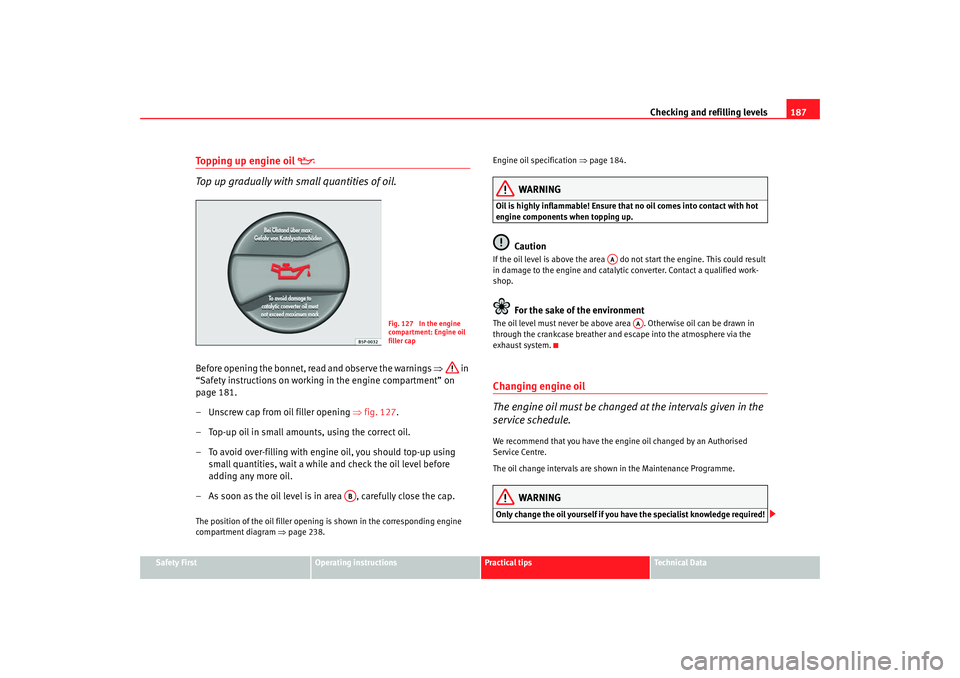
Checking and refilling levels187
Safety First
Operating instructions
Practical tips
Te c h n i c a l D a t a
Topping up engine oil
Top up gradually with small quantities of oil.
Before opening the bonnet, read and observe the warnings ⇒ in
“Safety instructions on working in the engine compartment” on
page 181.
– Unscrew cap from oil filler opening ⇒fig. 127.
– Top-up oil in small amounts, using the correct oil.
– To avoid over-filling with engine oil, you should top-up using small quantities, wait a while and check the oil level before
adding any more oil.
– As soon as the oil level is in area , carefully close the cap.The position of the oil filler opening is shown in the corresponding engine
compartment diagram ⇒page 238. Engine oil specification
⇒page 184.
WARNING
Oil is highly inflammable! Ensure that no oil comes into contact with hot
engine components when topping up.
Caution
If the oil level is above the area do not start the engine. This could result
in damage to the engine and catalytic converter. Contact a qualified work-
shop.
For the sake of the environment
The oil level must never be above area . Otherwise oil can be drawn in
through the crankcase breather and escape into the atmosphere via the
exhaust system.Changing engine oil
The engine oil must be changed at the intervals given in the
service schedule.We recommend that you have the engine oil changed by an Authorised
Service Centre.
The oil change intervals are shown in the Maintenance Programme.
WARNING
Only change the oil yourself if you have the specialist knowledge required!
Fig. 127 In the engine
compartment: Engine oil
filler cap
AB
AA
AA
Ibiza250_angles Seite 187 Dienstag, 5. August 2008 1:11 13
Page 190 of 260
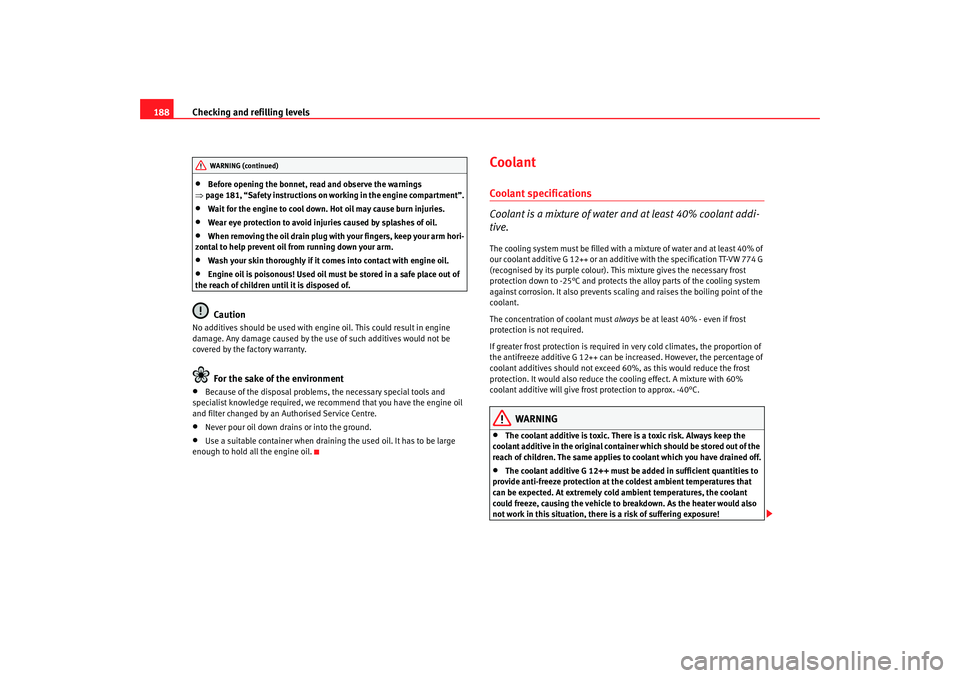
Checking and refilling levels
188•
Before opening the bonnet, read and observe the warnings
⇒ page 181, “Safety instructions on wo rking in the engine compartment”.
•
Wait for the engine to cool down. Hot oil may cause burn injuries.
•
Wear eye protection to avoid injuries caused by splashes of oil.
•
When removing the oil drain plug with your fingers, keep your arm hori-
zontal to help prevent oil from running down your arm.
•
Wash your skin thoroughly if it comes into contact with engine oil.
•
Engine oil is poisonous! Used oil must be stored in a safe place out of
the reach of children until it is disposed of.Caution
No additives should be used with engine oil. This could result in engine
damage. Any damage caused by the use of such additives would not be
covered by the factory warranty.
For the sake of the environment
•
Because of the disposal problems, the necessary special tools and
specialist knowledge required, we recommend that you have the engine oil
and filter changed by an Authorised Service Centre.
•
Never pour oil down drains or into the ground.
•
Use a suitable container when draining the used oil. It has to be large
enough to hold all the engine oil.
CoolantCoolant specifications
Coolant is a mixture of water and at least 40% coolant addi-
tive.The cooling system must be filled with a mixture of water and at least 40% of
our coolant additive G 12++ or an additive with the specification TT-VW 774 G
(recognised by its purple colour). T his mixture gives the necessary frost
protection down to -25°C and protects the alloy parts of the cooling system
against corrosion. It also prevents scal ing and raises the boiling point of the
coolant.
The concentration of coolant must always be at least 40% - even if frost
protection is not required.
If greater frost protection is required in very cold climates, the proportion of
the antifreeze additive G 12++ can be increased. However, the percentage of
coolant additives should not exceed 60%, as this would reduce the frost
protection. It would also reduce the cooling effect. A mixture with 60%
coolant additive will give frost protection to approx. -40°C.
WARNING
•
The coolant additive is toxic. Ther e is a toxic risk. Always keep the
coolant additive in the original container which should be stored out of the
reach of children. The same applies to coolant which you have drained off.
•
The coolant additive G 12++ must be added in sufficient quantities to
provide anti-freeze protection at the coldest ambient temperatures that
can be expected. At extremely cold ambient temperatures, the coolant
could freeze, causing the vehicle to breakdown. As the heater would also
not work in this situation, there is a risk of suffering exposure!
WARNING (continued)
Ibiza250_angles Seite 188 Dienstag, 5. August 2008 1:11 13
Page 195 of 260
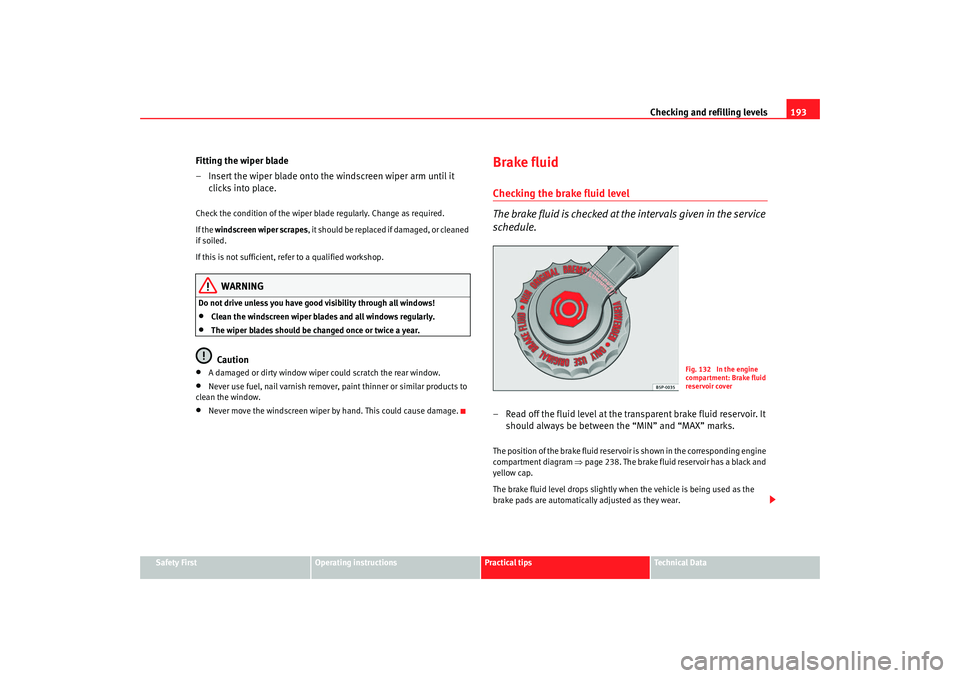
Checking and refilling levels193
Safety First
Operating instructions
Practical tips
Te c h n i c a l D a t a
Fitting the wiper blade
– Insert the wiper blade onto the windscreen wiper arm until it
clicks into place.Check the condition of the wiper blade regularly. Change as required.
If the windscreen wiper scrapes, it should be replaced if damaged, or cleaned
if soiled.
If this is not sufficient, refer to a qualified workshop.
WARNING
Do not drive unless you have good visibility through all windows!•
Clean the windscreen wiper blades and all windows regularly.
•
The wiper blades should be changed once or twice a year.Caution
•
A damaged or dirty window wiper could scratch the rear window.
•
Never use fuel, nail varnish remover, paint thinner or similar products to
clean the window.
•
Never move the windscreen wiper by hand. This could cause damage.
Brake fluidChecking the brake fluid level
The brake fluid is checked at the intervals given in the service
schedule.– Read off the fluid level at the transparent brake fluid reservoir. It should always be between the “MIN” and “MAX” marks.The position of the brake fluid reservoir is shown in the corresponding engine
compartment diagram ⇒page 238. The brake fluid reservoir has a black and
yellow cap.
The brake fluid level drops slightly when the vehicle is being used as the
brake pads are automatically adjusted as they wear.
Fig. 132 In the engine
compartment: Brake fluid
reservoir cover
Ibiza250_angles Seite 193 Dienstag, 5. August 2008 1:11 13
Page 196 of 260
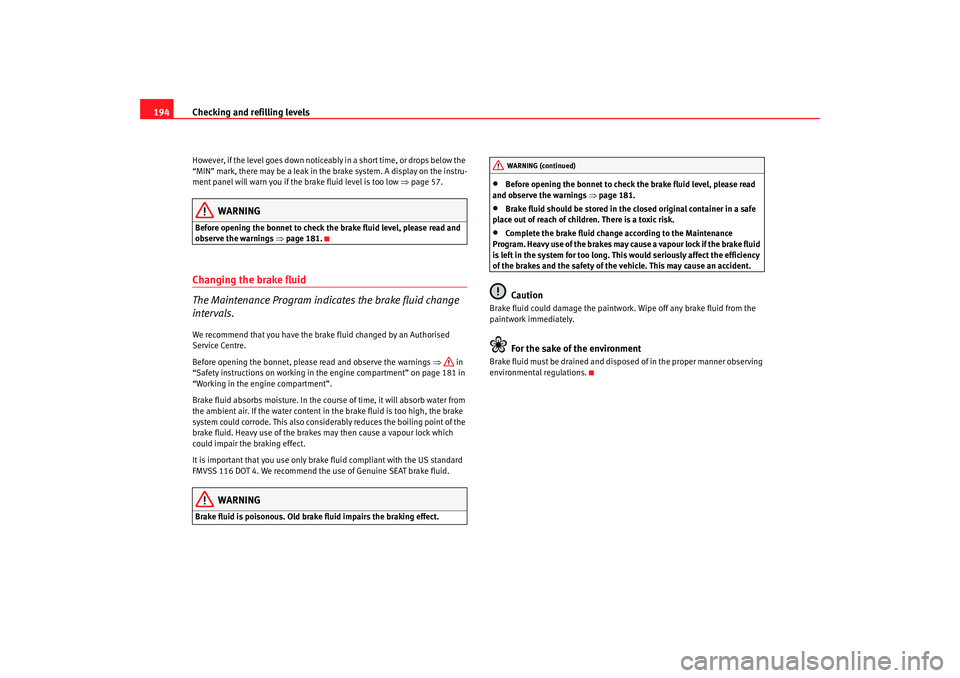
Checking and refilling levels
194However, if the level goes down noticeably in a short time, or drops below the
“MIN” mark, there may be a leak in the brake system. A display on the instru-
ment panel will warn you if the brake fluid level is too low ⇒page 57.
WARNING
Before opening the bonnet to check the brake fluid level, please read and
observe the warnings ⇒ page 181.Changing the brake fluid
The Maintenance Program indicates the brake fluid change
intervals.We recommend that you have the brake fluid changed by an Authorised
Service Centre.
Before opening the bonnet, please read and observe the warnings ⇒ in
“Safety instructions on working in the engine compartment” on page 181 in
“Working in the engine compartment”.
Brake fluid absorbs moisture. In the cour se of time, it will absorb water from
the ambient air. If the water content in the brake fluid is too high, the brake
system could corrode. This also considerably reduces the boiling point of the
brake fluid. Heavy use of the brakes may then cause a vapour lock which
could impair the braking effect.
It is important that you use only brake fluid compliant with the US standard
FMVSS 116 DOT 4. We recommend the use of Genuine SEAT brake fluid.
WARNING
Brake fluid is poisonous. Old brake fluid impairs the braking effect.
•
Before opening the bonnet to check the brake fluid level, please read
and observe the warnings ⇒page 181.
•
Brake fluid should be stored in the closed original container in a safe
place out of reach of children. There is a toxic risk.
•
Complete the brake fluid change according to the Maintenance
Program. Heavy use of the brakes may cause a vapour lock if the brake fluid
is left in the system for too long. Th is would seriously affect the efficiency
of the brakes and the safety of the vehicle. This may cause an accident.Caution
Brake fluid could damage the paintwork. Wipe off any brake fluid from the
paintwork immediately.
For the sake of the environment
Brake fluid must be drained and disposed of in the proper manner observing
environmental regulations.
WARNING (continued)
Ibiza250_angles Seite 194 Dienstag, 5. August 2008 1:11 13
Page 215 of 260
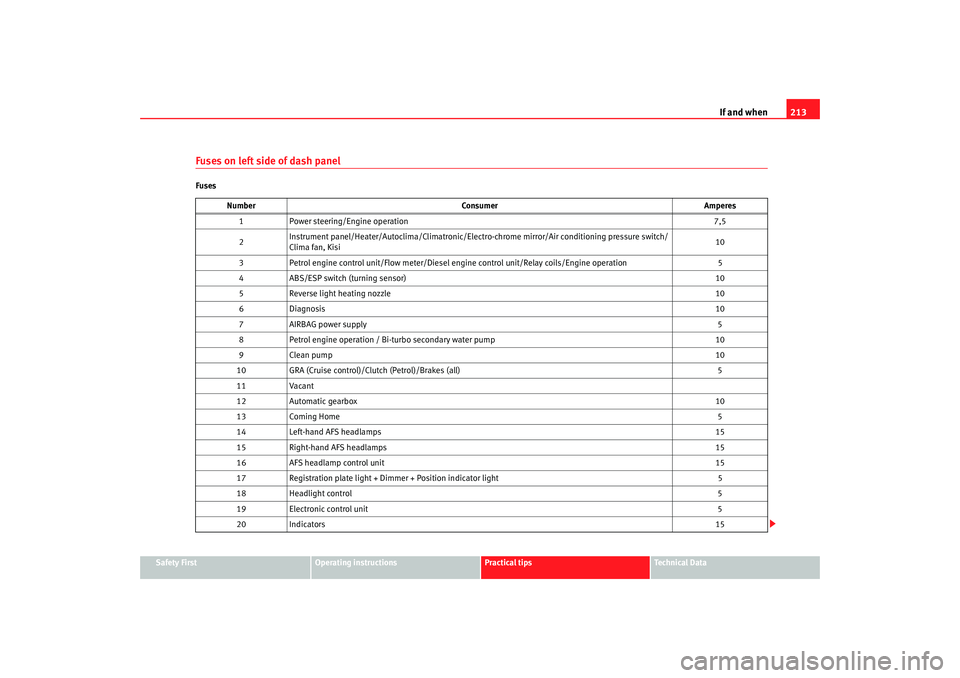
If and when213
Safety First
Operating instructions
Practical tips
Te c h n i c a l D a t a
Fuses on left side of dash panelFuses
Number Consumer Amperes
1 Power steering/Engine operation 7,5
2 Instrument panel/Heate
r/Autoclima/Climatronic/Electro-chrome mirror/Air conditioning pressure switch/
Clima fan, Kisi 10
3 Petrol engine control unit/Flow meter/Diesel engine control unit/Relay coils/Engine operation 5
4 ABS/ESP switch (turning sensor) 10
5 Reverse light heating nozzle 10
6 Diagnosis 10
7 AIRBAG power supply 5
8 Petrol engine operation / Bi-turbo secondary water pump 10
9C le a n p um p 10
10 GRA (Cruise control)/Clutch (Petrol)/Brakes (all) 5
11 Vacant
12 Automatic gearbox 10
13 Coming Home 5
14 Left-hand AFS headlamps 15
15 Right-hand AFS headlamps 15
16 AFS headlamp control unit 15
17 Registration plate light + Di mmer + Position indicator light 5
18 Headlight control 5
19 Electronic control unit 5
20 Indicators 15
Ibiza250_angles Seite 213 Dienstag, 5. August 2008 1:11 13
Page 216 of 260
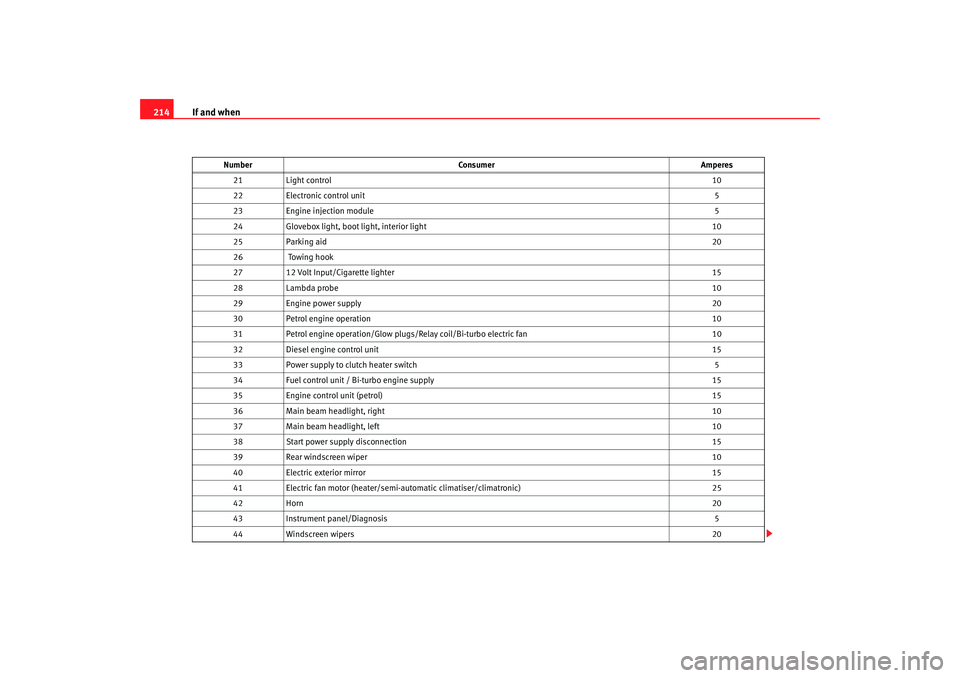
If and when
214
21 Light control 10
22 Electronic control unit 5
23 Engine injection module 5
24 Glovebox light, boot light, interior light 10
25 Parking aid 20
26 Towing hook
27 12 Volt Input/Cigarette lighter 15
28 Lambda probe 10
29 Engine power supply 20
30 Petrol engine operation 10
31 Petrol engine operation/Glow plugs/Relay coil/Bi-turbo electric fan 10
32 Diesel engine control unit 15
33 Power supply to clutch heater switch 5
34 Fuel control unit / Bi-turbo engine supply 15
35 Engine control unit (petrol) 15
36 Main beam headlight, right 10
37 Main beam headlight, left 10
38 Start power supply disconnection 15
39 Rear windscreen wiper 10
40 Electric exterior mirror 15
41 Electric fan motor (heater/semi-automatic climatiser/climatronic) 25
42 Horn 20
43 Instrument panel/Diagnosis 5
44 Windscreen wipers 20
Number
Consumer Amperes
Ibiza250_angles Seite 214 Dienstag, 5. August 2008 1:11 13
Page 240 of 260
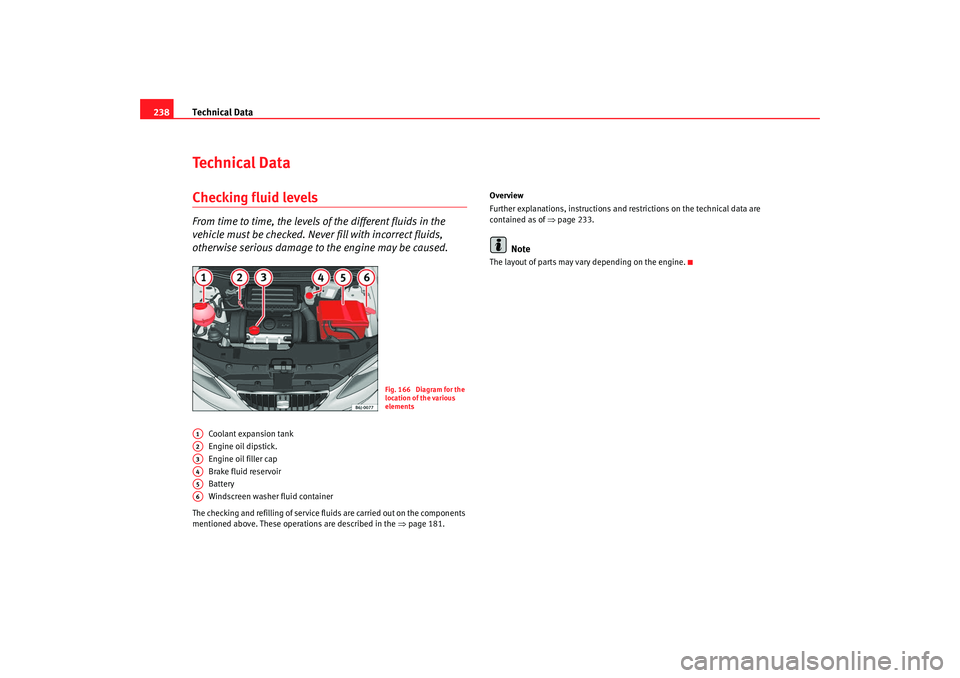
Technical Data
238Te c h n i c a l D a t aChecking fluid levelsFrom time to time, the levels of the different fluids in the
vehicle must be checked. Never fill with incorrect fluids,
otherwise serious damage to the engine may be caused.
Coolant expansion tank
Engine oil dipstick.
Engine oil filler cap
Brake fluid reservoir
Battery
Windscreen washer fluid container
The checking and refilling of service fluids are carried out on the components
mentioned above. These operations are described in the ⇒page 181. Overview
Further explanations, instructions and restrictions on the technical data are
contained as of
⇒page 233.
Note
The layout of parts may vary depending on the engine.
Fig. 166 Diagram for the
location of the various
elements
A1A2A3A4A5A6
Ibiza250_angles Seite 238 Dienstag, 5. August 2008 1:11 13
Page 242 of 260
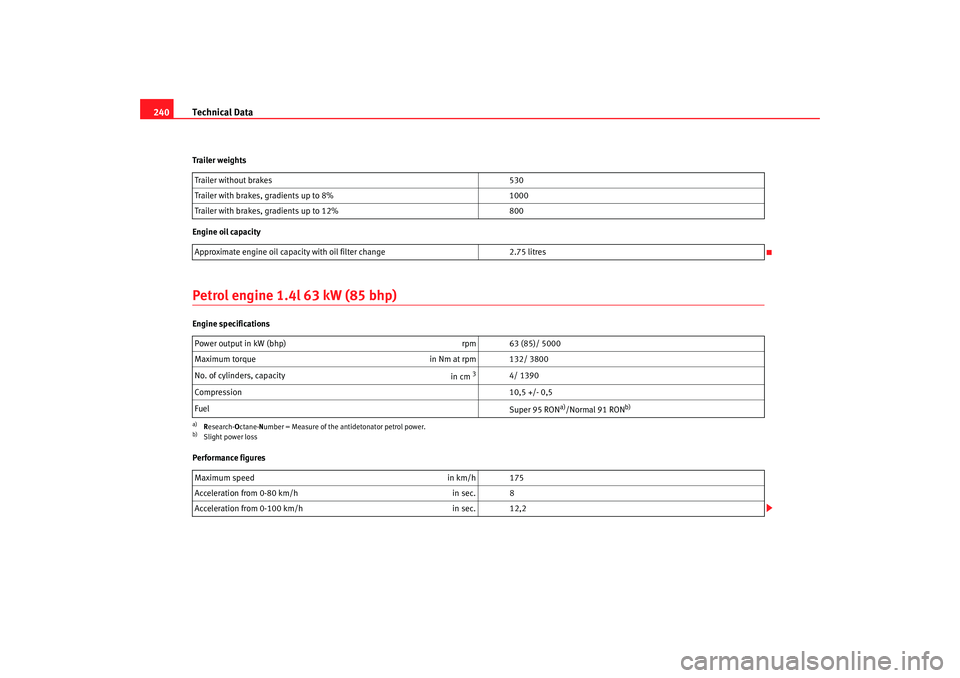
Technical Data
240Trailer weights
Engine oil capacityPetrol engine 1.4l 63 kW (85 bhp)Engine specifications
Performance figures Trailer without brakes
530
Trailer with brakes, gradients up to 8% 1000
Trailer with brakes, gradients up to 12% 800
Approximate engine oil capacity with oil filter change 2.75 litres
Power output in kW (bhp) rpm 63 (85)/ 5000
Maximum torque in Nm at rpm 132/ 3800
No. of cylinders, capacity in cm
3
4/ 1390
Compression 10,5 +/- 0,5
Fuel Super 95 RON
a)/Normal 91 RON
b)
a)Research- Octane- Number = Measure of the antidetonator petrol power.b)Slight power lossMaximum speed in km/h 175
Acceleration from 0-80 km/h in sec. 8
Acceleration from 0-100 km/h in sec. 12,2
Ibiza250_angles Seite 240 Dienstag, 5. August 2008 1:11 13